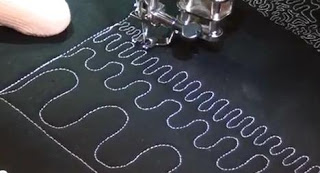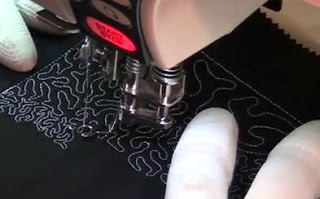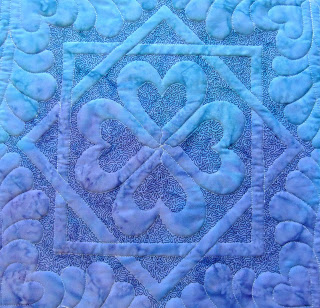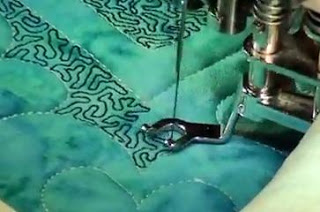Quilt Along #12 – Microstippling
Yes, it’s time finally time to take the classic Stippling design and shrink it down to a super tiny scale when it becomes Microstippling.
I may be wrong, but I do believe this is the only design we have that has one name for the large scale version, and another name for the smaller version. I think that’s a good indication of just how important Microstippling is to free motion quilting – super important!
This design does many things for our quilts, and because we’re working on a wholecloth right now you can see and appreciate just how much microstippling flattens out the background areas around the motifs. On top of flattening the surface, this design also has zero thread play or travel stitching, which means the design doesn’t stand out or shout for attention.
This combination of features makes Microstippling simply the best design for filling backgrounds, flattening the space around complex areas without competing with other designs or shapes.
Of course, I could wax on all day about my love for Stippling and Microstippling, so let’s get on with the video so you can learn a few different ways to shrink this design down to a smaller scale:
I’d say the two most essential items I used in this video were machingers quilting gloves and the isacord thread. The machingers allowed me to hang onto the quilt and achieve a very fine level of control over the design and the Isacord stitched out smoothly and didn’t break, even when the stitches got very tiny.
So let’s break down the steps to going dense one by one.
It will definitely help to review Quilt Along #3 – Playing with Scale and spend some time working down from a big scale to a smaller scale.
I used a small seam ripper I keep near my sewing machine as a visual guide to stitch a 1/4″ scale, then a 1/8″ scale, then a 1/16″ scale of the design. These measurements are not approximate, and you shouldn’t worry too much about measuring your design. The key is not really achieving any set scale, but simply to find a CONSISTENT scale that works for you.
So first start by going back to Quilt Along #1 – Let’s Wiggle, and wiggle your way through a 10 inch quilt sandwich with simple rows of stippling. I stuck with simple U shapes, but if you want to run through all the different types of shapes go for it!

As you work through each row, attempt to work on a smaller and smaller scale.
When you reach a point where you can’t help but cross your lines of quilting, you’ve probably reached the smallest scale you can stitch, so stay there for awhile and stitch several rows of various shapes, working to create a more and more complex version of stippling.

It’s a really good idea to practice this over a period of several days because you may find your skills suddenly improving overnight.
It might sound crazy, but working on a smaller scale seems to supercharge many quilters skill level. I personally believe it has something to do with understanding how the design works (which is easier on a smaller scale), which translates into better stitches, and an ability to stitch on a smaller and smaller.
Once you feel you’ve achieved a level of microstippling you’re comfortable with, it’s time to stitch it in your Heart and Feather Wholecloth.
As always, let’s get started in the center of the quilt. We’ve already stitched all the lines, so you’ll need to pull up thread in each heart. The best place to do this is in a point – either the end of the heart or the indentation that comes down – this is where your thread start will not be as noticeable.
Now it’s time to fill that heart with a very dense Microstippling.
I often find at the beginning of a project, particularly one I’m learning a tricky new technique, I have a lot of “false starts” and do a bit of ripping until I get into the rhythm of the design. If you can, spend 5 minutes microstippling on a scrap sandwich before actually quilting the real quilt. This will help you relax and get into the groove and make quilting the quilt much less intimidating.
When you fill the hearts, keep in mind that you’re stitching an extremely dense design onto fabric and batting – things will likely move and shift a bit. So make sure to stitch around the perimeter a bit, but also fill into the middle of the heart so you don’t allow all the extra fabric to puddle up in the middle of the heart.
Once you fill the hearts in the center, I expect quite a few of you will want to kill me because you will likely have around 16 threads to hide in the center of your quilt! Keep in mind that when you’re quilting a wholecloth on your own, you can easily combine the steps of outline quilting and filling so you have much fewer thread breaks.
But do take the time to hide all of those threads. You can find a video to show you a quick way of doing this right here.
Now it’s time to work on the space between the heart motif and the inner interlocking squares. I designed this wholecloth intentionally leaving very little space within this area. This means you should be able to quilt through the space with a single row of microstippling. Unless your bobbin runs out, you should be able to do this in a single pass, working clockwise or counterclockwise.

Now for the interlocking squares there are 8 triangles. Each one can easily be filled by starting in a point, then working a row across the shape to the second point, then another row to fill to the third point.

Yep, you’ll have another 32 loose threads to deal with here. Just turn on a good episode of Top Gear or Dr. Who and hide them all at once.
Now it’s time to fill the space between the outer interlocking squares and the feathers. This area is also quite narrow, but there are spaces where you’ll need to be careful of how you stitch and fill.
Just make sure to stitch evenly through the area, following along the edge of the feather a bit, but then stitch up to the straight lines for a bit so you don’t end up with pockets of excess batting and fabric in the middle.

Once you finish up with that last inner section, you’ll need to fill each heart in the corners as well. Yep, this will create another 64 loose threads to hide so take your time and try hiding them as you quilt each corner.
The only remaining section will be the outline of the quilt, filling to the edges with as much quilting as you’d like the quilt to have.
This would be a good time to lay a ruler over your quilt and figure out exactly how big you’d like it to finish. My red heart and feather wholecloth finished at 16 inches and has a nice bit of microstippling around the edges.
The trick is to not do more filling than you need to because it’s time consuming and can get tedious. Mark a line to indicate how far you need to fill, then only fill a bit past this line.
So that finishes the quilting of our Heart and Feather wholecloth!
Next week we’re going to finish up this project by soaking, blocking, trimming, and binding for a perfect finish.
I was going to try to include all that information in this post, but then realized we really need an updated post about binding and blocking so look forward to learning about that next week!
Now it’s time to link up your progress from last week’s Quilt Along #11!
Instructions for Linking Up Your Blog:
1. Write your blog post. Publish it on your blog.
2. Copy the link of the specific blog post. This is not just the link to your blog itself (www.freemotionquilting.blogspot.com), but the link to the specific post: https://freemotionproject.com/2012/01/quilt-along-2-quilting-in-rows.html
3. Click the blue link up button above and paste your link into the box.
Keep in mind that you’re posting your progress from LAST week on THIS week’s post. This way you have time to watch the lesson, play with the ideas, then post your progress to the next quilt along. I hope that makes sense!
As always, any questions you have, please post them in the comments below or on your blog and I’ll answer 5 tomorrow on Question Thursday.
Time for me to shut up and quilt,
Leah Day

You're a Doctor Who fan? Awesome!
So many threads! You're killing me! I hid them all from the outline stitching (all the separate hearts…), but I didn't even think of how many there would be from the stippling.
I always worry they will slip out in the wash. When I hid them from the outline quilting, I tried to push them into areas that would be stippled over, to catch them down. But I'm actually not sure if that is a good idea or not. Where do you normally put your threads? Do you give it any thought? Or just wherever?
Leah, is there any reason that you can't travel stitch to get to the next section of micro-stippling instead of breaking thread each time?
Jessim – Yes, that is most definitely a good idea. You won't likely throw this particular quilt in the washer too often, but it's good to make sure those threads are secured within the middle layer and won't come out to annoy you later.
Ashlea – You can most definitely travel stitch between the hearts if you like!
Keep in mind that it's pretty difficult to teach all the multiple options for quilting on a line plus filler quilting at the same time.
Rather than try to combine the two at once, I separated them and so only showed filler quilting this week.
You can most definitely simplify the process as much as you like to save time and thread breaks!
Cheers,
Leah
that's just lovely, I really want to do a whole cloth on the long arm, but maybe even small scale would work, I'd need micro handles though
whoa girls……look at us GO! 🙂
I love the blue one you did! I ended up breaking thread to do the inner heart part, but if I had seen one like your blue one, with the squiggly line, I might have done that! I like that look!
Leah I read your post after linking up. So not sure if you already read my post before updating my questions. So, I'm repeating my questions here:
1.You had mentioned that we need to break threads 16 times. My question is that instead could we travel stitch on the lines of motif if we're using the same thread for the microstippling as we did for the outline of the motif? This way I can get away with breaking the thread. I had connected the hearts with straight line.
2. Did you choose to use different color of thread for microstippling for video and picture purpose? Or do you suggest to use different color thread than the one used for outline because the motifs will pop more?
Thanks for all your information…really great! Now I would like to know if you were going to quilt a full sized quilt How do you manage all the quilt you aren't working on?
Thanks,
Nancy
Well, just found the time to finish my stippling. Wow, time consuming.. I will post a pick and share link as soon as camera charges.
I noticed that I did get better at the process by the time I was finished… but around the outside edge, my stippling got bigger. My scale, although not a huge…, throw it away mistake, stitches.. they did get bigger..lesson learned to check more often. I got in a bit of a zone and it seemed like things were going pretty smooth.
Hi, Leah! I love your blog and website and the videos are fantastic! I recently got my hands on some Isacord thread and I want you to know that you and Isacord have changed my quilting life! Isacord is the first thread I have used that looks as good on the back of the quilt as it does on the front! Fantastic! However…..I ordered three spools on the internet and of course the colors I ordered were quite different when I got them in the mail from what I saw on my computer screen! Do you know if Joann's carries Isacord? I'd like to be able to see the thread before I buy it! Anyway, thanks again for turning me on to this fantastic thread!!!!
I am absolutely in love with this little quilt! I did stop & start & practice burying my stitches – which wasn't as scary as I thought it would be. However here's my question:
How do you bury the ending threads? I got the hang of burying the starting threads, but I'm not sure how to pull up the bobbin thread again at the end. Do you just tie off each one separately (top & bottom) or do you somehow bring the bottom thread up again at the end of a line of stitching?
Thanks!!
Hi Leah, just wanted to say that I really enjoy watching you quilt. It's like dancing and it makes me smile every time. And now I have to do some sewing on my own. I am totally inspired!